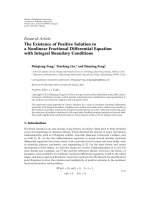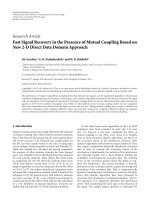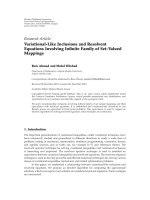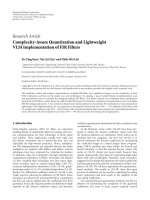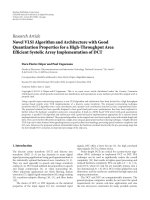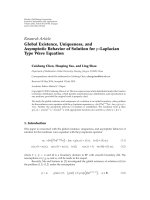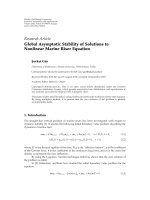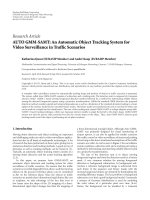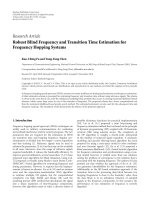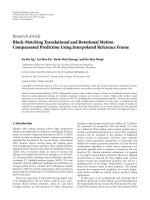Báo cáo hóa học: " Research Article Global Existence, Uniqueness, and Asymptotic Behavior of Solution for p-Laplacian Type Wave Equation" ppt
Bạn đang xem bản rút gọn của tài liệu. Xem và tải ngay bản đầy đủ của tài liệu tại đây (520.28 KB, 15 trang )
Hindawi Publishing Corporation
Journal of Inequalities and Applications
Volume 2010, Article ID 216760, 15 pages
doi:10.1155/2010/216760
Research Article
Global Existence, Uniqueness, and
Asymptotic Behavior of Solution for p-Laplacian
Type Wave Equation
Caisheng Chen, Huaping Yao, and Ling Shao
Department of Mathematics, Hohai University, Nanjing, Jiangsu, 210098, China
Correspondence should be addressed to Caisheng Chen,
Received 10 May 2010; Accepted 13 July 2010
Academic Editor: Michel C. Chipot
Copyright q 2010 Caisheng Chen et al. This is an open access article distributed under the Creative
Commons Attribution License, which permits unrestricted use, distribution, and reproduction in
any medium, provided the original work is properly cited.
We study the global existence and uniqueness of a solution to an initial boundary value problem
for the nonlinear wave equation with the p-Laplacian operator u
tt
−div|∇u|
p−2
∇u−Δu
t
gx, u
fx. Further, the asymptotic behavior of solution is established. The nonlinear term g likes
gx, uax|u|
α−1
u − bx|u|
β−1
u with appropriate functions ax and bx,whereα>β≥ 1.
1. Introduction
This paper is concerned with the global existence, uniqueness, and asymptotic behavior of
solution for the nonlinear wave equation with the p-Laplacian operator
u
tt
− div
|
∇u
|
p−2
∇u
− Δu
t
g
x, u
f
x
, in Ω ×
0, ∞
, 1.1
u
x, 0
u
0
x
,u
t
x, 0
u
1
x
, in Ω; u
x, t
0, on ∂Ω ×
0, ∞
, 1.2
where 2 ≤ p<nand Ω is a boundary domain in R
n
with smooth boundary ∂Ω.The
assumptions on f, g, u
0
and u
1
will be made in the sequel.
Recently, Ma and Soriano in 1 investigated the global existence of solution ut for
the problem 1.1-1.2 under the assumptions
p n, g
u
u ≥ 0,
g
u
≤ C
β
exp
β
|
u
|
n/n−1
,u∈ R. 1.3
2 Journal of Inequalities and Applications
Moreover, if f 0andugu ≥ Gu, then there exist positive constants c and γ such that
E
t
≤ c exp
−γt
,t≥ 0, if n 2, 1.4
E
t
≤ c
1 t
−n/n−2
,t≥ 0, if n ≥ 3,
1.5
where
E
t
1
2
u
t
t
2
2
1
n
∇u
t
n
n
Ω
G
x, u
t
dx
1.6
with Gx, u
u
0
fx, sds.
Gao and Ma in 2 also considered the global existence of solution f or 1.1-1.2.In
Theorem 3.1of2, the similar results to 1.4-1.5 for asymptotic behavior of solution were
obtained if the nonlinear function gx, ugu satisfies
g
u
≤ a
|
u
|
σ−1
b, ug
u
≥ ρG
u
≥ 0, in Ω × R
, 1.7
where a, b > 0,ρ>0, 1 <σ<np/n − p if 1 <p<nand 1 <σ<∞ if n ≤ p.
More precisely, they obtained that the global existence of solution for 1.1-1.2 if one
of the following assumptions was satisfied:
i 1 <σ<p, the initial data u
0
,u
1
∈ W
1,p
0
Ω × L
2
Ω;
ii p<σ, the initial data u
0
,u
1
∈ W
1,p
0
Ω × L
2
Ω is small.
Similar consideration can be found in 3–5.In6, Yang obtained the uniqueness of
solution of the Laplacian wave equation 1.1-1.2 for n 1. To the best of our knowledge,
there are few information on the uniqueness of solution of 1.1-1.2 for n>1andp>2.
In this paper, we are interested in the global existence, the uniqueness, the continuity
and the asymptotic behavior of solution for 1.1-1.2. The nonlinear term g in 1.1 likes
gx, uax|u|
α−1
u − bx|u|
β−1
u with α>β≥ 1anda, b ≥ 0. Obviously, the sign condition
ugu ≥ 0 fails to hold for this type of function.
For these purposes, we must establish the global existence of solution for 1.1-1.2.
Several methods have been used to study the existence of solutions to nonlinear wave
equation. Notable among them is the variational approach through the use of Faedo-Galerkin
approximation combined with the method of compactness and monotonicity, see 7.To
prove the uniqueness, we need to derive the various estimates for assumed solution ut.
For the decay property, like 1.5, we use the method recently introduced by Martinez 8 to
study the decay rate of solution to the wave equation u
tt
− Δu gu
t
0inΩ × R
, where Ω
is a bounded domain of R
n
.
This paper is organized as follows. In Section 2, some assumptions and the main
results are stated. In Section 3, we use Faedo-Galerkin approximation together with a
combination of the compactness and the monotonicity methods to prove the global existence
of solution to problem 1.1-1.2. Further, we establish the uniqueness of solution by some a
priori estimate t o assumed solutions. The proof of asymptotic behavior of solution is given in
Section 4.
Journal of Inequalities and Applications 3
2. Assumptions and Main Results
We first give some notations and definitions. Let Ω be a bounded domain in R
n
with smooth
boundary ∂Ω. We denote the space L
p
and W
1,p
0
for L
p
Ω and W
1,p
0
Ω and relevant norms
by ·
p
and ·
1,p
, respectively. In general, ·
X
denotes the norm of Banach space X.We
also denote by ·, · and ·, · the inner product of L
2
Ω and the duality pairing between
W
1,p
0
Ω and W
−1,p
Ω, respectively. As usual, we write ut instead ux, t. Sometimes, let
u
t represent for u
t
t and so on.
If T>0isgivenandX is a Banach space, we denote by L
p
0,T; X the space of
functions which are L
p
over 0,T and which take their values in X. In this space, we consider
the norm
u
L
p
0,T;X
T
0
u
t
p
X
dt
1/p
, 1 ≤ p<∞,
u
L
∞
0,T;X
esssup
0≤t≤T
u
t
X
.
2.1
Let us state our assumptions on f and g.
A
1
f ∈ L
p
with p
p/p − 1,p>1.
A
2
Let gx, u ∈ C
1
Ω × R and satisfy
ug
x, u
h
1
x
|
u
|
≥ k
0
G
x, u
h
1
x
|
u
|
≥ 0, in Ω × R 2.2
and growth condition
g
x, u
≤ k
1
|
u
|
α
h
2
x
,
g
u
x, u
≤ k
1
|
u
|
α−1
h
3
x
, in Ω × R 2.3
with some k
0
,k
1
> 0 and the nonnegative functions h
1
x ∈ L
p
, h
2
∈ L
2
∩ L
α1/α
, h
3
∈
L
2
∩ L
α1/α−1
, where 1 ≤ α ≤ np/n − p − 1, Gx, u
u
0
gx, sds.
A typical function g is gx, uax|u|
α−1
u − bx|u|
β−1
u with the appropriate
nonnegative functions ax and bx, where α>β≥ 1.
Definition 2.1 see 7. A measurable function u ux, t on Ω × R
is said to be a weak
solution of 1.1-1.2 if all T>0, u ∈ L
∞
0,T; W
1,p
0
, u
t
∈ L
2
0,T; W
1,2
0
, u
tt
∈ L
2
0,T; W
−1,p
,
and u satisfies 1.2 with u
0
,u
1
∈ W
1,p
0
and the integral identity
Ω
u
tt
φ
|
∇u
|
p−2
∇u ·∇φ ∇u
t
·∇φ gφ − fφ
dx 0
2.4
for all φ ∈ C
∞
0
Ω.
Now we are in a position to state our results.
4 Journal of Inequalities and Applications
Theorem 2.2. Assume A
1
-A
2
hold and u
0
,u
1
∈ W
1,p
0
×L
2
. Then the problem 1.1-1.2 admits
a solution ut satisfying
u ∈ C
0, ∞
; ,W
1,2
0
∩ L
∞
0, ∞
; ,W
1,p
0
,
u
t
∈ L
2
0, ∞
; ,W
1,2
0
,u
tt
∈ L
2
loc
0, ∞
; ,W
−1,p
,
2.5
and the following estimates
∇u
t
t
2
2
∇ut
p
p
t
0
∇u
t
s
2
2
ds ≤ C
1
A B
, ∀t ≥ 0,
2.6
where
A
u
0
p
p
∇u
0
α1
p
u
1
2
2
,B H
1
H
2
H
3
F,
2.7
with F f
p
p
,H
i
h
i
p
p
,i 1, 2,H
3
h
3
λ
1
λ
1
,λ
1
n/2.
Further, if 1 ≤ α ≤ n p/n − p and 2 ≤ p ≤ 4, the solution satisfying 2.5-2.6 is
unique.
Theorem 2.3. Let u be a solution of 1.1-1.2 with f 0. In addition, let 2 <p<nand
g
x, u
u ≥ pG
x, u
≥ 0, in Ω × R. 2.8
Then there exists C
0
C
0
u
0
,u
1
, such that
∇u
t
t
2
2
∇ut
p
p
Ω
G
x, u
x, t
dx ≤ C
0
1 t
−p/p−2
, ∀t ≥ 0
. 2.9
The following theorem shows that the asymptotic estimate 2.9 can be also derived if
assumption 2.8 fails to hold.
Theorem 2.4. Let u be a solution of 1.1-1.2 with f 0. In addition, let 2 <p<nand
g
x, u
λ
|
u
|
α−1
u −
|
u
|
β−1
u, in Ω × R
2.10
with p<β1 < 2p, β < α < np/n−p. Then there exists C
0
C
0
u
0
,u
1
> 0 and λ
2
λ
2
α, β > 0,
such that λ>λ
2
, the solution ut satisfies
∇u
t
t
2
2
∇ut
p
p
ut
α1
α1
≤ C
0
1 t
−p/p−2
, ∀t ≥ 0.
2.11
Journal of Inequalities and Applications 5
3. Proof of Theorem 2.2
In this section, we assume that all assumptions in Theorem 2.2 are satisfied. We first prove
the global existence of a solution to problem 1.1-1.2 with the Faedo-Galerkin method as
in 1, 2, 7, 9.
Let r be an integer for which the embedding H
r
0
Ω W
r,2
0
Ω → W
1,p
0
Ω is
continuous. Let w
j
j 1, 2, be eigenfunctions of the spectral problem
w
j
,v
H
r
0
λ
j
w
j
,v
, ∀v ∈ H
r
0
Ω
, 3.1
where ·, ·
H
r
0
represents the inner product in H
r
0
Ω. Then the family {w
1
,w
2
, ,w
m
, }
yields a basis for both H
r
0
Ω and L
2
Ω. For each integer m,letV
m
span{w
1
,w
2
, ,w
m
}.
We look for an approximate solution to problem 1.1-1.2 in the form
u
m
t
m
j1
T
jm
t
w
j
, 3.2
where T
jm
t are the solution of the nonlinear ODE system in the variant t:
u
m
,w
j
−
Δ
p
u
m
,w
j
−
Δu
m
,w
j
g,w
j
f, w
j
,j 1, 2, m 3.3
with the p-Laplacian operator Δ
p
u div|∇u|
p−2
∇u and the initial conditions
u
m
0
u
0m
,u
m
0
u
1m
, 3.4
where u
0m
and u
1m
arechoseninV
m
so that
u
0m
−→ u
0
in W
1,p
0
,u
1m
−→ u
1
in L
2
. 3.5
As it is well known, the system 3.3-3.4 has a local solution u
m
t on some interval
0,t
m
. We claim that for any T>0, such a solution can be extended to the whole interval 0,T
by using the first a priori estimate below. We denote by C
k
the constant which is independent
of m and the initial data u
0
and u
1
.
Multiplying 3.3 by T
jm
t and summing the resulting equations over j,wegetafter
integration by parts
E
m
t
∇u
m
t
2
2
0, ∀t ≥ 0, 3.6
where
E
m
t
1
2
u
m
t
2
2
1
p
∇u
m
t
p
p
Ω
G
x, u
m
dx −
Ω
f
x
u
m
dx. 3.7
6 Journal of Inequalities and Applications
By 2.2 and Young inequality, we have
Ω
G
x, u
m
dx ≥−
Ω
h
1
x
|
u
m
|
dx ≥−ε
∇u
m
p
p
− C
ε
h
1
p
p
,
Ω
f
x
u
m
dx ≥−ε
∇u
m
p
p
− C
ε
f
p
p
.
3.8
Let ε>0 be so small t hat 2p
−1
− 4ε ≥ p
−1
. Then
E
m
t
≥
1
2
u
m
t
2
2
1
2p
∇u
m
t
p
p
− C
1
H
1
F
,
3.9
or
u
m
t
2
2
∇u
m
t
p
p
≤ C
1
E
m
t
H
1
F
1
3.10
for some C
1
> 0.
Thus, it follows from 3.6 and 3.10 that, for any m 1, 2, ,and t ≥ 0
u
m
t
2
2
∇u
m
t
p
p
t
0
∇u
m
s
2
2
ds ≤ C
2
E
m
0
H
1
F
1
. 3.11
By assumption A
2
,weobtainthatα 1 ≤ np/n − p and
Ω
G
x, u
m
dx
≤ k
1
u
m
α1
α1
Ω
|
h
2
||
u
m
|
dx
≤ C
2
∇u
m
α1
p
u
m
p
p
h
2
p
p
≤ C
2
∇u
m
α1
p
∇u
m
p
p
H
2
.
3.12
Then it follows 3.5 and 3.6 that
E
m
t
≤ E
m
0
1
2
u
1m
2
2
1
p
∇u
0m
p
p
Ω
G
x, u
0m
dx −
Ω
f
x
u
0m
dx
≤ C
2
u
1
2
2
∇u
0
p
p
∇u
0
α
p
H
1
H
2
F
≤ C
2
A B
.
3.13
Hence, for any t ≥ 0andm 1, 2, , we have from 3.11 and 3.13 that
u
m
t
2
2
∇u
m
t
p
p
t
0
∇u
m
s
2
2
ds ≤ C
2
A B
, ∀t ≥ 0. 3.14
Journal of Inequalities and Applications 7
With this estimate we can extend the approximate solution u
m
t to the interval 0,T
and we have that
{
u
m
t
}
is bounded in L
∞
0,T; W
1,p
0
, 3.15
{
u
m
t
}
is bounded in L
∞
0,T; L
2
, 3.16
{
u
m
t
}
is bounded in L
2
0,T; W
1,2
0
. 3.17
Now we recall that operator −Δ
p
u − div|∇u|
p−2
∇u is bounded, monotone, and
hemicontinuous from W
1,p
0
to W
−1,p
with p ≥ 2. Then we have
−Δ
p
u
m
t
is bounded L
∞
0,T; W
−1,p
. 3.18
By the standard projection argument as in 1, we can get from the approximate
equation 3.3 and the estimates 3.15–3.17 that
u
m
t
is bounded in L
2
0,T;H
−r
Ω
.
3.19
From 3.15-3.16, going to a subsequence if necessary, there exists u such that
u
m
uweakly star in L
∞
0,T; W
1,p
0
, 3.20
u
m
u
weakly star in L
∞
0,T; L
2
, 3.21
u
m
u
weakly in L
2
0,T; L
2
, 3.22
and in view of 3.18, there exists χt such that
−Δ
p
u
m
t
χ
t
weakly star in L
∞
0,T; W
−1,p
. 3.23
By applying the Lions-Aubin compactness Lemma in 7,weget,from3.15 and
3.16,
u
m
−→ u strongly in L
2
0,T; L
2
, 3.24
and u
m
→ u a.e. in Ω × 0,T.
8 Journal of Inequalities and Applications
Since the embedding W
1,2
0
→ L
2
is compact, we get, from 3.18 and 3.19,
u
m
−→ u
strongly in L
2
0,T; L
2
. 3.25
Using the growth condition 2.3 and 3.25,weseethat
T
0
Ω
g
x, u
m
x, t
α1/α
dx dt
3.26
is bounded and
g
x, u
m
−→ g
x, u
a.e. in
Ω × T
. 3.27
Therefore, from 7, C hapter 1, Lemma 1.3, we infer that
g
x, u
m
g
x, u
weakly in L
α1/α
0,T; L
α1/α
. 3.28
With these convergences, we can pass to the limit in the approximate equation and
then
d
dt
u
t
,v
χ
t
,v
∇u
, ∇v
g,v
f, v
, ∀v ∈ W
1,p
0
.
3.29
Obviously, u satisfies the estimates 2.5-2.6. Finally, using the standard monotonic-
ity argument as done in 1, 7,wegetthatχt−Δ
p
ut. This completes the proof of
existence of solution ut.
To prove the uniqueness, we assume that ut and vt are two solutions which satisfy
2.5-2.6 and u0v0,u
t
0v
t
0. Setting Utu
t
t,Vtv
t
t,andWt
Ut − V t.Weseefrom1.1 and 1.2 that
W
t
− ΔW − div
|
∇u
|
p−2
∇u −
|
∇v
|
p−2
∇v
g
x, v
− g
x, u
. 3.30
Multiplying 3.30 by W and integrating over Ω, we have
1
2
d
dt
Wt
2
2
∇Wt
2
2
Ω
|
∇u
|
p−2
∇u −
|
∇v
|
p−2
∇v
∇Wdx
Ω
g
x, v
− g
x, u
Wdx,
W
t
2
2
2
t
0
∇Ws
2
2
ds 2
t
0
Ω
|
∇u
|
p−2
∇u −
|
∇v
|
p−2
∇v
∇Wdxdτ
2
t
0
Ω
g
x, v
− g
x, u
Wdxds
3.31
Journal of Inequalities and Applications 9
Now setting U
u 1 − v, 0 ≤ ≤ 1, then
t
0
Ω
|
∇u
|
p−2
∇u −
|
∇v
|
p−2
∇v
∇W
dx dτ
≤
t
0
Ω
1
0
d
d
|
∇U
|
p−2
∇U
d
|
∇W
|
dx dτ
≤
p − 1
t
0
Ω
1
0
|
∇U
|
p−2
|
∇
u
τ
− v
τ
||
∇W
|
d dx dτ ≡ I.
3.32
Note that
|
∇U
τ
|
≤
|
∇u
τ
|
|
∇v
τ
|
,
|
∇
u
τ
− v
τ
|
≤
τ
0
|
∇
u
s
s
− v
s
s
|
ds
τ
0
|
∇W
s
|
ds.
3.33
Then, by the estimates 2.6 and 2 ≤ p ≤ 4, we have
I ≤ C
1
t
0
Ω
τ
0
|
∇u
τ
|
p−2
|
∇v
τ
|
p−2
|
∇W
s
||
∇W
τ
|
dx ds dτ
≤ C
1
t
0
τ
0
∇u
τ
p−2
p
∇v
τ
p−2
p
∇Ws
2
∇Wτ
2
ds dτ
≤ C
1
A B
p−2/p
t
0
τ
0
∇Ws
2
∇Wτ
2
ds dτ
≤ C
1
A B
p−2/p
t
0
∇W
s
2
ds
2
≤ C
2
t
t
0
∇Ws
2
2
ds
3.34
with C
2
C
1
A B
p−2/p
.
For the term of the right side to 3.31, we have
G
1
t
0
Ω
g
x, v
− g
x, u
|
W
|
dx dτ
t
0
Ω
1
0
d
d
g
x, U
d
|
W
|
dx dτ
≤
t
0
Ω
1
0
g
u
x, U
u
τ
− v
τ
W
τ
d dxdτ
≤
t
0
τ
0
1
0
g
u
x, U
λ
1
d
u
s
s − v
s
s
λ
2
Wτ
λ
2
d ds dτ
3.35
with λ
1
n/2, λ
2
2n/n − 2.
10 Journal of Inequalities and Applications
By the assumption A
2
and 1 ≤ α ≤ n p/n − p,weseethat
g
u
x, U
λ
1
λ
1
≤ k
1
Ω
|
u
τ
|
α−1
|
v
τ
|
α−1
|
h
3
|
n/2
dx
≤ C
3
Ω
|
u
τ
|
nα−1/2
|
v
τ
|
nα−1/2
|
h
3
|
n/2
dx
≤ C
3
∇u
τ
nα−1/2
p
∇v
τ
nα−1/2
p
H
3
.
3.36
By the estimate 2.6, we have
∇ut
p
,
vt
p
≤ C
2
A B
1/p
, ∀t ≥ 0.
3.37
Therefore, there exists C
4
> 0, depending u
0
,v
0
,f,h
i
such that
g
u
x, U
λ
1
≤ C
4
, ∀t ≥ 0.
3.38
Since u, v ∈ W
1,p
0
⊂ W
1,2
0
, u
t
,v
t
∈ W
1,2
0
,weget
u
s
s − v
s
s
λ
2
≤ C
0
∇
u
s
s
− v
s
s
2
C
0
∇Ws
2
,
W
τ
2
≤ C
0
∇W
τ
2
.
3.39
Then 3.35 becomes
G
1
≤ C
4
t
0
τ
0
W
s
λ
2
Wτ
λ
2
dsdτ ≤ C
4
t
0
∇W
s
2
ds
2
≤ C
4
t
t
0
∇Ws
2
2
ds.
3.40
Therefore, it follows from 3.31, 3.34,and3.40 that
Wt
2
2
2
t
0
∇W
s
2
2
ds ≤
C
2
C
4
t
t
0
∇Ws
2
2
. 3.41
The integral inequality 3.41 shows that there exists T
1
> 0, such that
W
t
0, 0 ≤ t ≤ T
1
. 3.42
Consequently, ut − vtu0 − v00, 0 ≤ t ≤ T
1
.
Journal of Inequalities and Applications 11
Repeating the above procedure, we conduce that utvt on T
1
, 2T
1
, 2T
1
, 3T
1
,
and utvt on 0, ∞. This ends the proof of uniqueness.
Next, we prove that u ∈ C0, ∞; W
1,2
0
.Lett>s≥ 0, we have
∇
u
t
− u
s
2
2
Ω
t
s
∇u
τ
τdτ
2
dx ≤
Ω
t
s
|
∇u
τ
τ
|
2
ds dx
t − s
t − s
t
s
∇u
τ
τ
2
2
dτ −→ 0, as t −→ s.
3.43
This shows that ut ∈ C0, ∞; W
1,2
0
. We complete the proof of Theorem 2.2.
4. Proof of Theorem 2.3
Let us first state a well-known lemma that will be needed later.
Lemma 4.1 see 10. Let E : R
→ R
be a nonincreasing function and assume that there are
constants q ≥ 0 and γ>0, such that
∞
S
E
q1
t
dt ≤ γ
−1
E
q
0
E
S
, ∀S ≥ 0
. 4.1
Then, we have
E
t
≤ E
0
1 q
1 qγt
1/q
, ∀t ≥ 0, if q>0,
E
t
≤ E
0
e
1−γt
, ∀t ≥ 0, if q 0.
4.2
4.1. The Proof of Theorem 2.3
Let
E
t
1
2
u
t
t
2
2
1
p
∇ut
p
p
Ω
G
x, u
dx, t ≥ 0
. 4.3
Then, we have from 1.1 that
E
t
∇u
t
t
2
2
0, ∀t ≥ 0.
4.4
This shows that Et is nonincreasing in 0, ∞.
12 Journal of Inequalities and Applications
Multiplying 1.1 by E
q
tut with q p − 2/p > 0, we get
T
S
E
q
t
Ω
u
u
tt
− Δ
p
u − Δu
t
g
x, u
dx dt 0, ∀T>S≥ 0. 4.5
Note that
T
S
E
q
t
u, u
tt
dt E
q
t
u, u
t
|
T
S
−
T
S
qE
q−1
t
E
t
u, u
t
E
q
t
u
t
t
2
2
dt
−
T
S
E
q
t
u, Δ
p
u
dt
T
S
E
q
t
∇u
t
p
p
dt,
−
T
S
E
q
t
u, Δu
t
dt
T
S
E
q
t
∇u, ∇u
t
dt.
4.6
Then we have from 4.5 that
p
T
S
E
q1
t
dt −E
q
tu, u
t
|
T
S
q
T
S
E
q−1
t
E
t
u, u
t
dt
1
p
2
T
S
E
q
t
u
t
t
2
2
dt −
T
S
E
q
t
∇u, ∇u
t
dt
T
S
E
q
t
Ω
pG
u
− ug
u
dx dt.
4.7
Since
Ω
Gx, udx ≥ 0, Et ≥ 0. Further, by 4.4,weseethat
∇u
t
t
2
≤
−E
t
1/2
,
∇ut
p
≤ pE
1/p
t
, ∀t ≥ 0,
|
E
q
t
u, u
t
|
≤ E
q
t
u
t
2
u
t
t
2
≤ C
0
E
q
t
∇u
t
p
∇u
t
t
2
≤ C
0
E
t
μ
1
4.8
with μ
1
q 1/2 1/p.
This gives
E
q
tu, u
t
|
T
S
≤ C
1
E
μ
1
S
, ∀T>S≥ 0
, 4.9
where the fact that Et is nonincreasing is used.
Journal of Inequalities and Applications 13
Similarly, we derive the following estimates
T
S
E
q
t
u
t
t
2
2
dt ≤ C
1
T
S
E
q
t
∇u
t
t
2
2
dt
C
1
T
S
E
q
t
−E
t
dt ≤ C
1
E
q1
S
,
4.10
q
T
S
E
q−1
t
E
t
u, u
t
dt ≤ C
1
T
S
E
q−1
t
E
t
ut
2
u
t
t
2
dt
≤ C
1
T
S
E
μ
1
−1
t
E
t
dt ≤ C
1
E
μ
1
S
,
4.11
T
S
|
E
q
t
∇u, ∇u
t
|
dt ≤
T
S
E
q
t
∇ut
2
∇u
t
t
2
dt
≤ C
1
T
S
E
q1/p
t
−E
t
1/2
dt
≤
T
S
E
q1
t
dt C
1
T
S
E
q2/p−1
t
−E
t
dt
≤
T
S
E
q1
t
dt C
1
E
q2/p
S
.
4.12
Then we get from 4.9–4.12 that
T
S
E
q1
t
dt ≤ C
1
E
μ
1
S
E
q1
S
E
q2/p
S
≤ C
1
E
S
E
μ
1
S
E
q
S
E
q2/p−1
S
≤ C
1
E
S
E
q
0
E
1/p−1/2
0
1 E
2/p−1
0
≡ γ
−1
E
q
0
E
S
,
4.13
for any T>S≥ 0, letting T →∞,wefindthat
∞
S
E
q1
t
dt ≤ γ
−1
E
S
E
q
0
, ∀S ≥ 0.
4.14
By Lemma 4.1,weobtainthat
E
t
1
2
u
t
t
2
2
1
p
∇u
t
p
p
Ω
G
x, u
dx ≤ E
0
1 q
1 qγt
1/q
≤ C
2
E
0
1 t
−p/p−2
.
4.15
This is 2.9 and we complete the proof of Theorem 2.3.
14 Journal of Inequalities and Applications
4.2. The Proof of Theorem 2.4
By Sobolev inequality, we know that there exists λ
0
> 0 such that
λ
0
u
p
p
≤
∇u
p
p
, ∀u ∈ W
1,p
0
Ω
. 4.16
Let u be a solution for 1.1-1.2 in Theorem 2.2.By2.10,
G
u
λ
α 1
|
u
|
α1
−
1
β 1
|
u
|
β1
. 4.17
Obviously, there exists λ
2
> 0, such that λ>λ
2
,
λ
0
2p
|
u
|
p
G
u
≥
1
2
α 1
|
u
|
α1
, ∀u ∈ R.
4.18
This implies that
λ
0
2p
u
p
p
Ω
G
u
dx ≥
1
2
α 1
u
α1
α1
,
E
t
≥
1
2
u
t
t
2
2
1
2p
∇u
t
p
p
1
2
α 1
ut
α1
α1
.
4.19
On the other hand, we have, from 4.18 and 4.19,
pG
u
− ug
u
β 1 − p
β 1
|
u
|
β1
−
λ
α 1 − p
α 1
|
u
|
α1
≤
β 1 − p
β 1
|
u
|
β1
β 1 − p
λ
α 1
|
u
|
α1
− G
u
≤
β 1 − p
λ
0
p
|
u
|
p
G
u
.
4.20
It shows that
T
S
E
q
t
Ω
pG
u
− gu
dxdt ≤
β 1 − p
T
S
E
q1
t
dt. 4.21
Then, by 4.9 and 4.11–4.14, we have
2p − β − 1
T
S
E
q1
t
dt ≤ C
0
E
q1/p2
S
E
q1
S
E
q2/p
S
≤ γ
−1
E
S
E
q
0
.
4.22
Journal of Inequalities and Applications 15
The applications of Lemma 4.1 and 4.19 yields that
u
t
t
2
2
∇ut
2
2
ut
α1
α1
≤ C
0
1 t
−p/p−2
, ∀t ≥ 0
. 4.23
This ends the proof of Theorem 2.4.
Acknowledgments
The authors express their sincere gratitude to the anonymous referees for a number of
valuable comments and suggestions. The work was supported by the Science Funds of Hohai
University Grant Nos. 2008430211 and 2008408306 and the Fundamental Research Funds
for the Central Universities Grant No. 2010B17914.
References
1 T. F. Ma and J. A. Soriano, “On weak solutions for an evolution equation with exponential
nonlinearities,” Nonlinear Analysis: Theory, Methods & Applications, vol. 37, no. 8, pp. 1029–1038, 1999.
2 H. Gao and T. F. Ma, “Global solutions for a nonlinear wave equation with the p-Laplacian operator,”
Electronic Journal of Qualitative Theory of Differential Equations, no. 11, pp. 1–13, 1999.
3 A. Benaissa and A. Guesmia, “Energy decay for wave equations of φ-Laplacian type with weakly
nonlinear dissipation,” Electronic Journal of Differential Equations, vol. 2008, no. 109, pp. 1–22, 2008.
4 A. C. Biazutti, “On a nonlinear evolution equation and its applications,” Nonlinear Analysis: Theory,
Methods & Applications, vol. 24, no. 8, pp. 1221–1234, 1995.
5 M. Nakao and Z. J. Yang, “Global attractors for some quasi-linear wave equations with a strong
dissipation,” Advances in Mathematical Sciences and Applications, vol. 17, no. 1, pp. 89–105, 2007.
6 Z. J. Yang, “Existence and asymptotic behaviour of solutions for a class of quasi-linear evolution
equations with non-linear damping and source terms,” Mathematical Methods in the Applied Sciences,
vol. 25, no. 10, pp. 795–814, 2002.
7 J L. Lions, Quelques M
´
ethodes de R
´
esolution des Probl
`
emes aux Limites non Lin
´
eaires, Dunod-Gauthier
Villars, Paris, France, 1969.
8 P. Martinez, “A new method to obtain decay rate estimates for dissipative systems,” ESAIM: Control,
Optimisation and Calculus of Variations, vol. 4, pp. 419–444, 1999.
9 M. Sango, “On a nonlinear hyperbolic equation with anisotropy: global existence and decay of
solution,” Nonlinear Analysis: Theory, Methods & Applications, vol. 70, no. 7, pp. 2816–2823, 2009.
10 V. K omo rni k, Exact Controllability and Stabilization: The Multiplier Method, RAM: Research in Applied
Mathematics, John Wiley & Sons, Chichester, UK; Masson, Paris, France, 1994.
